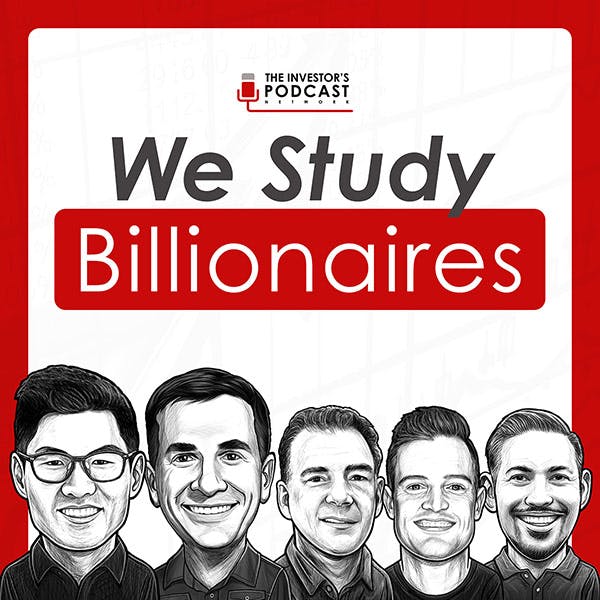
June 2, 2024 • 1hr 14min
TIP635: Deep Diving Into The Warren Buffett Way w/ Robert Hagstrom
We Study Billionaires - The Investor’s Podcast Network

Key Takeaways
- Warren Buffett's early investing mistakes taught him valuable lessons, particularly about patience and the importance of buying good businesses rather than just cheap stocks
- Low turnover portfolios tend to outperform over the long run, as frequent trading incurs costs and taxes that eat into returns
- Viewing stocks as abstractions of businesses rather than just ticker symbols has been a key advantage for Buffett
- Buffett has made long-term thinking into a competitive advantage, focusing on business fundamentals rather than short-term market movements
- Modern portfolio theory became dominant in finance despite flaws in its assumptions about risk and diversification
- Investors should focus on certainties in their investing strategy, like the economics of a business, quality of management, and purchase price
- Franchise businesses with strong competitive advantages have been some of Buffett's best investments
- Buffett's purposeful detachment from short-term market movements has been critical to his long-term success
Introduction
In this episode, host Kyle Grieve interviews Robert Hagstrom, author of "The Warren Buffett Way" and an expert on Warren Buffett's investment philosophy and career. They discuss key insights from the newly released 4th edition of Hagstrom's book, exploring Buffett's evolution as an investor, his most important principles, and how his approach differs from conventional investing wisdom.
Topics Discussed
Buffett's Early Investing Mistakes and Lessons (3:39)
Hagstrom discusses Buffett's first stock investment in City Service Preferred shares, which taught him an important lesson about patience:
- Buffett sold the shares too early due to pressure from his sisters, missing out on larger gains
- This experience reinforced the importance of having conviction and patience with investments
"I think that was deeply grained into his psyche, even at that young age. And so I think, you know, patience was something that he learned early in life," says Hagstrom.
The Dexter Shoe Acquisition Mistake (5:32)
They discuss one of Buffett's biggest mistakes - the acquisition of Dexter Shoe in 1993:
- Buffett used Berkshire stock to purchase Dexter Shoe, which was decimated by low-cost foreign competition
- This was similar to his earlier mistake with the Berkshire textile mill
- It highlighted the importance of avoiding businesses vulnerable to low-cost competition
Insurance Float and Berkshire's Advantage (9:07)
Hagstrom explains why other insurance companies don't leverage their float like Berkshire:
- Capital ratios: Berkshire's strong capital position allows more investment flexibility
- Long-tail policies: Some Berkshire insurance products have claims paid out years later, allowing longer-term investments
- Investing skill: Few insurance companies have investors as skilled as Buffett managing their float
Low Turnover and Concentrated Portfolios (11:07)
They discuss research showing the outperformance of low turnover, concentrated portfolios:
- High active share: Portfolios that differ significantly from the index tend to outperform
- Low turnover: Less trading reduces costs and taxes, improving returns
- Psychological challenge: This approach requires tolerating periods of underperformance
"The mistakes I've made is miscalculating the persistence of the company to generate high returns of capital over time," Hagstrom quotes Buffett.
Viewing Stocks as Abstractions (18:59)
Hagstrom explains how Buffett views stocks differently than most investors:
- Buffett sees stocks as ownership stakes in businesses, not just tradable securities
- He focuses on business fundamentals rather than stock price movements
- This mindset allows him to ignore short-term market noise and focus on long-term value
"Warren thinks that stocks are really an abstraction. Common stocks in on themselves are really abstractions. He doesn't think in terms of common stocks, sectors, correlations, diversification," says Hagstrom.
Buffett's Evolution as an Investor (26:16)
They discuss how Buffett's approach has evolved while maintaining core principles:
- Early influence of Benjamin Graham's value investing approach
- Shift from "cigar b**t" investing to focusing on high-quality businesses
- Incorporation of Philip Fisher's qualitative analysis and focus on growth
Modern Portfolio Theory and Its Flaws (46:43)
Hagstrom provides historical context for the rise of modern portfolio theory (MPT):
- Developed by Harry Markowitz in 1952 with limited real-world investing experience
- Gained prominence after the 1973-74 bear market when investors sought new approaches
- Became dominant despite flaws in its assumptions about risk and diversification
"Here's this 25 year old boy who's never invested in the stock market, never owned a company, never been in business anything, and he's all of a sudden going to define risk as variance volatility," Hagstrom critiques.
Buffett's View on Risk (58:27)
They explore Buffett's different perspective on investment risk:
- Risk is the possibility of harm to the intrinsic value of a business
- Focuses on certainty about business economics, management quality, and purchase price
- Not concerned with short-term stock price fluctuations
Franchise Businesses and Competitive Advantage (1:03:18)
Hagstrom discusses Buffett's preference for businesses with strong competitive advantages:
- Seeks businesses with products/services that are needed, have no close substitutes, and aren't heavily regulated
- Examples include Coca-Cola, GEICO, and potentially some modern tech companies
- Focuses on businesses that are difficult for competitors to displace
The Rule of One (1:09:05)
They discuss Buffett's "Rule of One" for evaluating capital allocation:
- For each dollar a business retains, it should create at least one dollar of market value
- Helps identify businesses that are creating or destroying value over time
- Most useful when evaluated over longer time periods to smooth out market fluctuations
Buffett's Critical Attributes (1:14:29)
Hagstrom identifies what he believes is Buffett's most important attribute:
- Purposeful detachment from the stock market
- Focuses on businesses rather than stock prices or market movements
- Allows him to make rational decisions and avoid emotional reactions
"If you said to me what is the one single characteristic that has made Warren Buffett successful? It's been his purposeful detachment from all things that are stock market," concludes Hagstrom.
Conclusion
This episode provides deep insights into Warren Buffett's investment philosophy and approach, highlighting how his methods differ from conventional investing wisdom. Key themes include the importance of patience, focusing on business fundamentals rather than short-term market movements, and the advantages of a long-term perspective. Hagstrom emphasizes that while Buffett's methods can be understood and potentially replicated, the temperament and discipline required to follow his approach consistently is challenging for most investors. The discussion underscores the enduring value of Buffett's principles in a market often driven by short-term thinking and complex theories.









